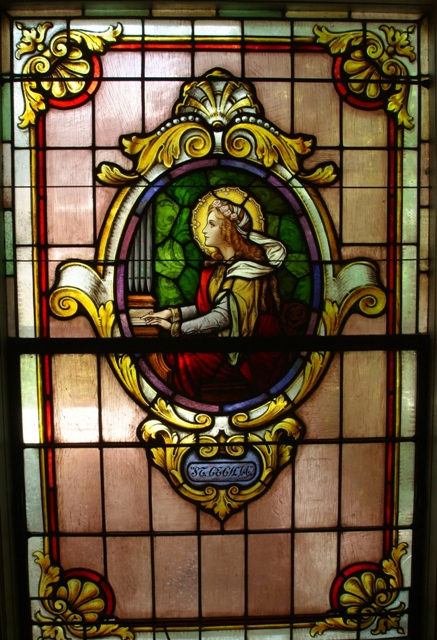
St. Cecilia
Leading to the choir loft in the east staircase of the Chapel is a portrait of St. Cecilia, the patron saint of church music, a fitting subject for the location. St. Cecilia’s act of singing to God during her wedding earned her the role of intercessor for all things musical. Jacobus de Voragine in his Golden Legend, an important late medieval compendium of saints’ lives, records Cecilia’s words as “Let my heart and my body be undefiled, O Lord, that I may not be confounded.”
Cecilia lived in Rome during the early centuries of Christianity, a period when Christians were routinely persecuted. Born into a Christian senatorial family, Cecilia was given in marriage to a young pagan named Valerianus. The young man’s status is not known, though most likely he came from an upper-class family. On the couple’s wedding night Cecilia, with the help of the Bishop Urbanus, convinced Valerianus to live chastely with her and to engage in acts of charity, such burying Christian martyrs. The young couple’s activities gained them notoriety among Christians but brought them the wrath of the pagan authorities, who had them martyred. It is believed that the pair’s remains rest today in the Roman catacombs. When the Academy of Music was established in Rome in 1584, Cecilia was made its patroness, an act which universalized her role as the patron saint of music.
The window at St. John’s depicts a beautiful, young St. Cecilia playing the organ, the instrument most often associated with her. She does not face the viewer but rather looks intently at the organ, perhaps to a musical score. She wears a gown of white and gold covered by a red cloak. Her head is uncovered, a sign of her maidenhood, except for ribbons. The artist has placed the holy portrait inside an oval cartouche decorated with scrolls and foliate forms reminiscent of those in the windows in the nave of the church. All who visit St. John’s should make sure to visit this lovely portrait.
Cecilia lived in Rome during the early centuries of Christianity, a period when Christians were routinely persecuted. Born into a Christian senatorial family, Cecilia was given in marriage to a young pagan named Valerianus. The young man’s status is not known, though most likely he came from an upper-class family. On the couple’s wedding night Cecilia, with the help of the Bishop Urbanus, convinced Valerianus to live chastely with her and to engage in acts of charity, such burying Christian martyrs. The young couple’s activities gained them notoriety among Christians but brought them the wrath of the pagan authorities, who had them martyred. It is believed that the pair’s remains rest today in the Roman catacombs. When the Academy of Music was established in Rome in 1584, Cecilia was made its patroness, an act which universalized her role as the patron saint of music.
The window at St. John’s depicts a beautiful, young St. Cecilia playing the organ, the instrument most often associated with her. She does not face the viewer but rather looks intently at the organ, perhaps to a musical score. She wears a gown of white and gold covered by a red cloak. Her head is uncovered, a sign of her maidenhood, except for ribbons. The artist has placed the holy portrait inside an oval cartouche decorated with scrolls and foliate forms reminiscent of those in the windows in the nave of the church. All who visit St. John’s should make sure to visit this lovely portrait.